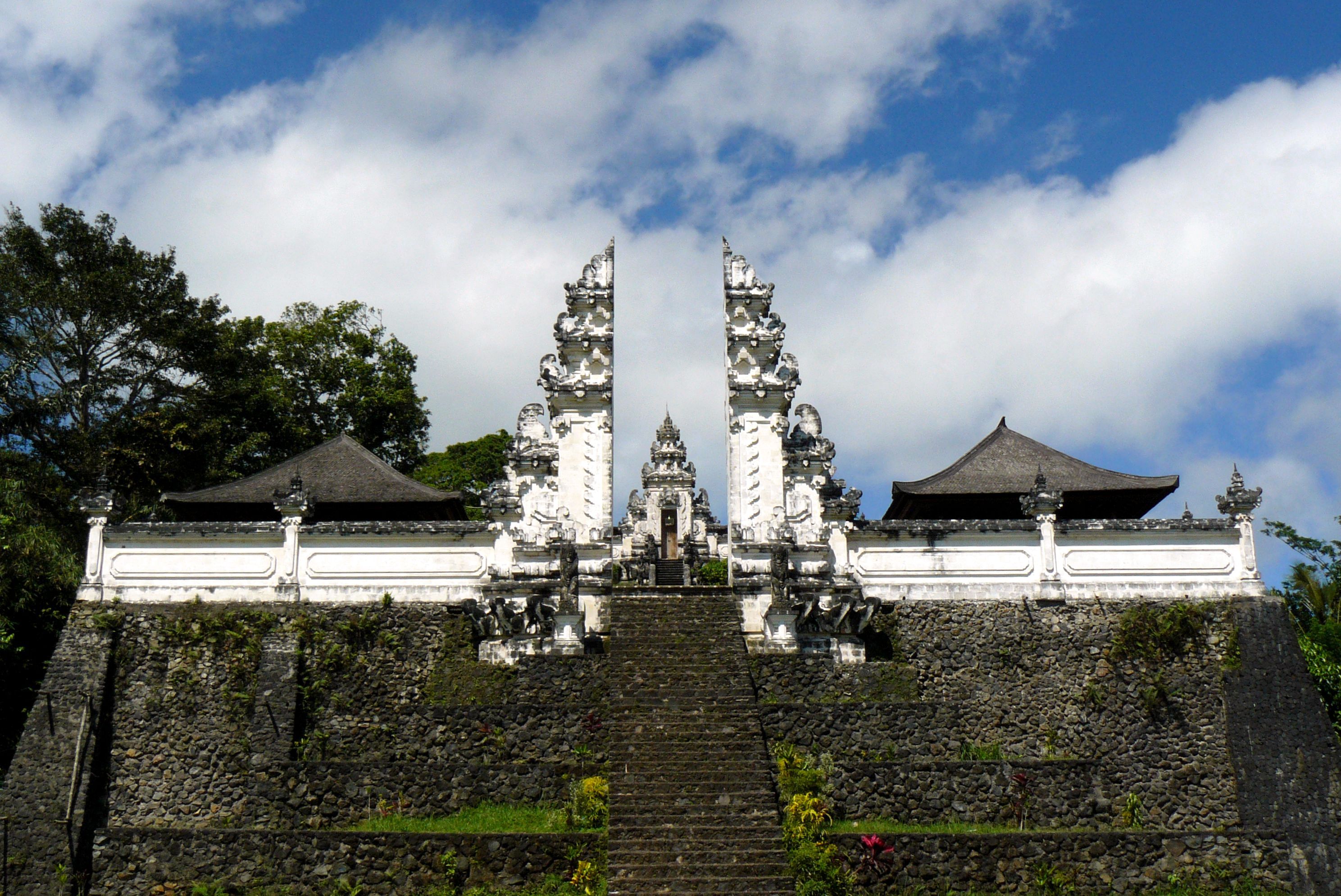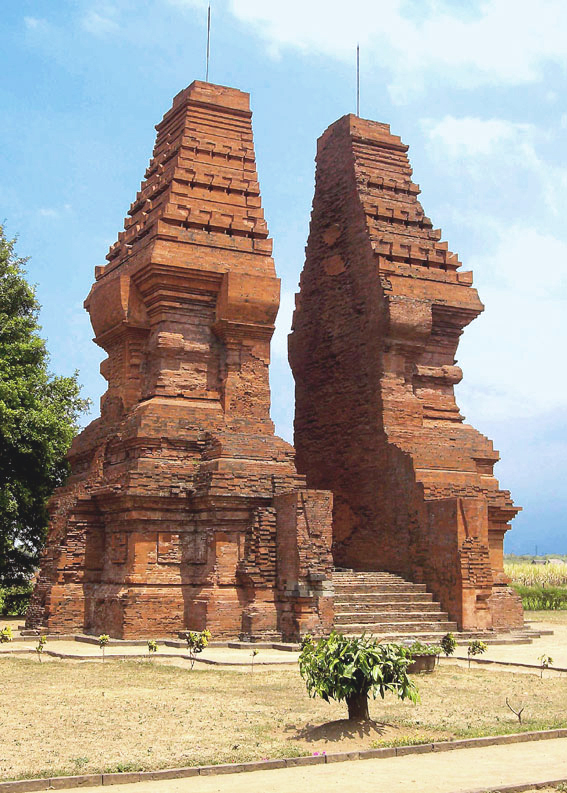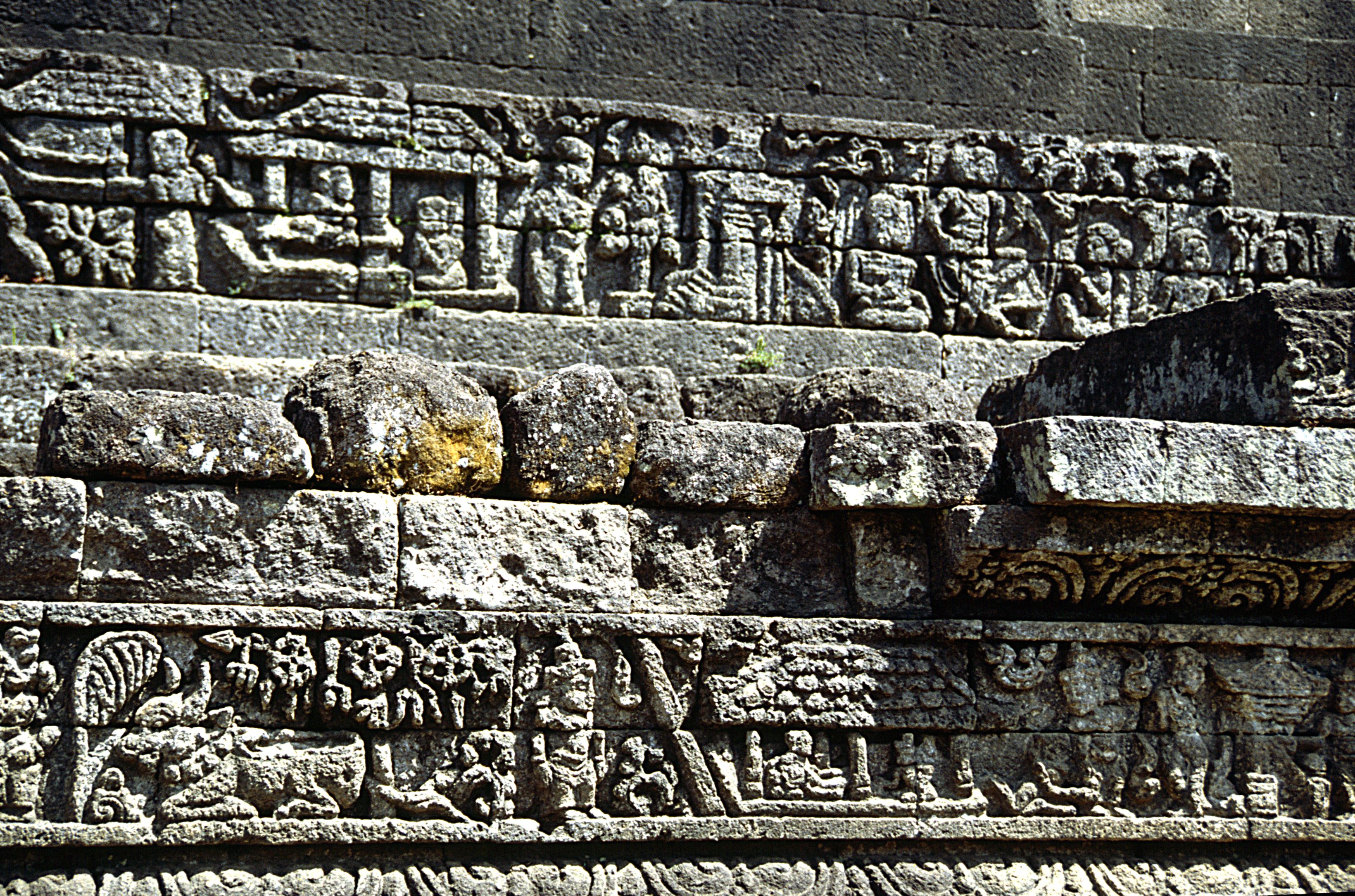candi bentar on:
[Wikipedia]
[Google]
[Amazon]
 Candi bentar, or split gateway, is a classical Javanese and Balinese gateway entrance commonly found at the entrance of religious compounds,
Candi bentar, or split gateway, is a classical Javanese and Balinese gateway entrance commonly found at the entrance of religious compounds,
 Candi bentar has a candi-like form but split perfectly in two to create a symmetrical image. Candi bentar characteristically has a stepped profile, which can be heavily decorated in the case of Balinese candi bentar. The two inner surfaces are always left sheer and unornamented, as if the structure has been split in two.
There are several different styles of candi bentar, from plain red bricks structure of Majapahit-style with its derivations of
Candi bentar has a candi-like form but split perfectly in two to create a symmetrical image. Candi bentar characteristically has a stepped profile, which can be heavily decorated in the case of Balinese candi bentar. The two inner surfaces are always left sheer and unornamented, as if the structure has been split in two.
There are several different styles of candi bentar, from plain red bricks structure of Majapahit-style with its derivations of
 Candi bentar and
Candi bentar and
 Candi bentar is thought to dates back to the Hindu period of
Candi bentar is thought to dates back to the Hindu period of  The current prevalence of candi bentar is probably owed to the influence of
The current prevalence of candi bentar is probably owed to the influence of
File:Masjid Menara Kudus Tampak Depan.jpg, The Majapahit style candi bentar of
 Candi bentar, or split gateway, is a classical Javanese and Balinese gateway entrance commonly found at the entrance of religious compounds,
Candi bentar, or split gateway, is a classical Javanese and Balinese gateway entrance commonly found at the entrance of religious compounds, palaces
A palace is a grand residence, especially a royal residence, or the home of a head of state or some other high-ranking dignitary, such as a bishop or archbishop. The word is derived from the Latin name palātium, for Palatine Hill in Rome whic ...
, or cemeteries in Indonesia
Indonesia, officially the Republic of Indonesia, is a country in Southeast Asia and Oceania between the Indian and Pacific oceans. It consists of over 17,000 islands, including Sumatra, Java, Sulawesi, and parts of Borneo and New Guine ...
. It is basically a candi-like structure split perfectly in two to create a passage in the center for people to walk through. In contrast to the very ornate shape and decoration of the main faces, the sides of the passage are left completely plain. The passage is usually elevated with a flight of stairs to reach it. A candi bentar is commonly found in Java
Java (; id, Jawa, ; jv, ꦗꦮ; su, ) is one of the Greater Sunda Islands in Indonesia. It is bordered by the Indian Ocean to the south and the Java Sea to the north. With a population of 151.6 million people, Java is the world's List ...
, Bali
Bali () is a province of Indonesia and the westernmost of the Lesser Sunda Islands. East of Java and west of Lombok, the province includes the island of Bali and a few smaller neighbouring islands, notably Nusa Penida, Nusa Lembongan, and Nu ...
, and Lombok
Lombok is an island in West Nusa Tenggara province, Indonesia. It forms part of the chain of the Lesser Sunda Islands, with the Lombok Strait separating it from Bali to the west and the Alas Strait between it and Sumbawa to the east. It is rou ...
.
Form
 Candi bentar has a candi-like form but split perfectly in two to create a symmetrical image. Candi bentar characteristically has a stepped profile, which can be heavily decorated in the case of Balinese candi bentar. The two inner surfaces are always left sheer and unornamented, as if the structure has been split in two.
There are several different styles of candi bentar, from plain red bricks structure of Majapahit-style with its derivations of
Candi bentar has a candi-like form but split perfectly in two to create a symmetrical image. Candi bentar characteristically has a stepped profile, which can be heavily decorated in the case of Balinese candi bentar. The two inner surfaces are always left sheer and unornamented, as if the structure has been split in two.
There are several different styles of candi bentar, from plain red bricks structure of Majapahit-style with its derivations of Cirebon
Cirebon (, formerly rendered Cheribon or Chirebon in English) is a port city on the northern coast of the Indonesian island of Java. It is the only coastal city of West Java, located about 40 km west of the provincial border with Central Java ...
, Demak, Kudus and early Mataram Sultanate style, the stucco-coated split gates of Kaibon Palace in Banten also in city of Surakarta and Yogyakarta, to the richly adorned split gates of Balinese temples and palaces compound.
Other than narrowing the passage, candi bentar do not serve a real defensive purpose, since this type of split gates are originally designed not to have doors. Additional iron fences are seldom to never installed in the passage, if so they usually added later and not part of the original design. The symbolism of a candi bentar is unclear. Candi bentar probably only serve for aesthetic purpose, to create a sense of grandeur before entering a compound.
Classical Javanese and Balinese Hindu temple
 Candi bentar and
Candi bentar and paduraksa
Paduraksa, also known as kori is a type of gateway covered with towering roof that can be found in the island of Java and Bali, Indonesia. This architectural feature is commonly found in buildings from the classical Hindu-Buddhist period of Indone ...
(another gateway structure) are integral features of a Balinese temple
A pura is a Balinese Hindu temple, and the place of worship for adherents of Balinese Hinduism in Indonesia. Puras are built in accordance to rules, style, guidance and rituals found in Balinese architecture. Most puras are found on the island o ...
architecture, and possibly the classical Javanese Hindu temple. Both gateways mark the threshold between different level of sanctity within a temple compound. Candi bentar marks the boundary between the outer world with the outer realm of the Hindu temple
A Hindu temple, or ''mandir'' or ''koil'' in Indian languages, is a house, seat and body of divinity for Hindus. It is a structure designed to bring human beings and gods together through worship, sacrifice, and devotion.; Quote: "The Hind ...
, the '' nista mandala
A mandala ( sa, मण्डल, maṇḍala, circle, ) is a geometric configuration of symbols. In various spiritual traditions, mandalas may be employed for focusing attention of practitioners and adepts, as a spiritual guidance tool, for e ...
'' ("outer sanctum"). The paduraksa
Paduraksa, also known as kori is a type of gateway covered with towering roof that can be found in the island of Java and Bali, Indonesia. This architectural feature is commonly found in buildings from the classical Hindu-Buddhist period of Indone ...
marks the boundary between the '' madya mandala
A mandala ( sa, मण्डल, maṇḍala, circle, ) is a geometric configuration of symbols. In various spiritual traditions, mandalas may be employed for focusing attention of practitioners and adepts, as a spiritual guidance tool, for e ...
'' ("middle sanctum") with the innermost and the most sacred '' utama mandala
A mandala ( sa, मण्डल, maṇḍala, circle, ) is a geometric configuration of symbols. In various spiritual traditions, mandalas may be employed for focusing attention of practitioners and adepts, as a spiritual guidance tool, for e ...
'' ("main sanctum").
The compound within Balinese temples
A pura is a Balinese Hindu temple, and the place of worship for adherents of Balinese Hinduism in Indonesia. Puras are built in accordance to rules, style, guidance and rituals found in Balinese architecture. Most puras are found on the island of ...
and palaces are usually used for rituals. The candi bentar usually used as a background of dance performances, as the performers appears from behind the split gates. Sometimes the dance performance took place in inner compound with roofed paduraksa
Paduraksa, also known as kori is a type of gateway covered with towering roof that can be found in the island of Java and Bali, Indonesia. This architectural feature is commonly found in buildings from the classical Hindu-Buddhist period of Indone ...
gate as a background.
Origin and evolution
 Candi bentar is thought to dates back to the Hindu period of
Candi bentar is thought to dates back to the Hindu period of Singhasari
Singhasari ( jv, ꦏꦫꦠꦺꦴꦤ꧀ꦱꦶꦔ꧀ꦲꦱꦫꦶ, translit=Karaton Singhasari or , id, Kerajaan Singasari) was a Javanese Hindu kingdom located in east Java between 1222 and 1292. The kingdom succeeded the Kingdom of Kediri as ...
and Majapahit
Majapahit ( jv, ꦩꦗꦥꦲꦶꦠ꧀; ), also known as Wilwatikta ( jv, ꦮꦶꦭ꧀ꦮꦠꦶꦏ꧀ꦠ; ), was a Javanese people, Javanese Hinduism, Hindu-Buddhism, Buddhist thalassocracy, thalassocratic empire in Southeast Asia that was ba ...
in 13th to 14th-century Java
Java (; id, Jawa, ; jv, ꦗꦮ; su, ) is one of the Greater Sunda Islands in Indonesia. It is bordered by the Indian Ocean to the south and the Java Sea to the north. With a population of 151.6 million people, Java is the world's List ...
. Reliefs showing a candi bentar and paduraksa
Paduraksa, also known as kori is a type of gateway covered with towering roof that can be found in the island of Java and Bali, Indonesia. This architectural feature is commonly found in buildings from the classical Hindu-Buddhist period of Indone ...
have been discovered in 13th-century Candi Jago
Jago temple ( Indonesian: ''Candi Jago'') is a 13th-century Hindu temple from the Singhasari kingdom in East Java, Indonesia, located about 22 km from Malang. The Nagarakretagama written in 14th century mentioned this temple, as ''Jajaghu'' ...
in East Java
East Java ( id, Jawa Timur) is a Provinces of Indonesia, province of Indonesia located in the easternmost hemisphere of Java island. It has a land border only with the province of Central Java to the west; the Java Sea and the Indian Ocean bord ...
.
In the archaeological site of Trowulan
Trowulan is an archaeological site in Trowulan Subdistrict, Mojokerto Regency, in the Indonesian province of East Java. It includes approximately 100 square kilometres and has been theorized to be the site of the eponymous capital city of the ...
– the 14th-century capital of the Majapahit empire – a candi bentar named ''Wringin Lawang'' (Javanese "the Banyan Tree Gate"), is among the oldest candi bentar that still stands. The Wringin Lawang took the shape of a typical Majapahit temple structure evenly split into two mirroring structures, creating a passage in the center. The grand gate portals are made from red brick, with a base of 13 x 11 metres and a height of 15.5 metres
 The current prevalence of candi bentar is probably owed to the influence of
The current prevalence of candi bentar is probably owed to the influence of Majapahit
Majapahit ( jv, ꦩꦗꦥꦲꦶꦠ꧀; ), also known as Wilwatikta ( jv, ꦮꦶꦭ꧀ꦮꦠꦶꦏ꧀ꦠ; ), was a Javanese people, Javanese Hinduism, Hindu-Buddhism, Buddhist thalassocracy, thalassocratic empire in Southeast Asia that was ba ...
aesthetics on Javanese and Balinese architecture. The candi bentar is still widely used upon the arrival of Islam
Islam (; ar, ۘالِإسلَام, , ) is an Abrahamic religions, Abrahamic Monotheism#Islam, monotheistic religion centred primarily around the Quran, a religious text considered by Muslims to be the direct word of God in Islam, God (or ...
period in the 15th century. The Sultanate palace of The Keraton Kasepuhan
The Kraton Kasepuhan is the oldest kraton (sultan's palace) in the Indonesian city of Cirebon. It is the residence of the Sultan of Kasepuhan and the royal palace of Sultanate of Cirebon.
History
It was built in 1447 and its architecture an ...
used candi bentar to mark access into the public audience pavilion.
The 16th-century Menara Kudus Mosque
The Menara Kudus Mosque or Al-Aqsha Mosque is located in Kudus, Kudus, Kudus in the Indonesian province of Central Java. Dating from 1549, it is one of the oldest mosques in Indonesia, built at the time of The spread of Islam in Indonesia, Islam' ...
, one of the oldest mosque in Java, still has a candi bentar in its compound, marking the gateway into the mosque compound. A Muslim cemetery complex of Sendang Duwur in the village of Sendang Duwur, Lamongan Regency
Lamongan Regency is a regency ''(kabupaten)'' of East Java, Indonesia. It has a total land area of approximately or + 3.78% of the area of East Java Province. With a length of along the coastline, the sea area of Lamongan Regency is about , if ...
, East Java, contains both candi bentar and paduraksa to marks the level of sanctity within the cemetery complex, with the tomb of Sunan Sendang Duwur being the most sacred part of the cemetery complex. Other Javanese tombs employing the candi bentar is the Sunan Giri
Sunan Giri (also called Raden Paku or Joko Samudro), Muhammad Ainul Yakin (born 1442 CE in Blambangan (now Banyuwangi) is considered one of the Wali Sanga (revered saints of Islam) of Indonesia.
History
He was the son of Dewi Sekardadu and ...
cemetery complex.
In modern period, construction of candi bentar is encouraged by the Indonesian government. This policy is especially encouraged by municipal and regional kabupaten government as a form of regional identity. The government of Banten province for example, encouraged the construction of candi bentar — modelled after Kaibon Palace of Old Banten
Old Banten (Indonesian ''Banten Lama'') is an archaeological site in the northern coast of Serang Regency, Banten, Indonesia. Located 11 km north of Serang city, the site of Old Banten contains the ruin of the walled port city of Banten, the 1 ...
, in the entrance gate of houses, especially those located along the main road. In the city of Cirebon
Cirebon (, formerly rendered Cheribon or Chirebon in English) is a port city on the northern coast of the Indonesian island of Java. It is the only coastal city of West Java, located about 40 km west of the provincial border with Central Java ...
, West Java
West Java ( id, Jawa Barat, su, ᮏᮝ ᮊᮥᮜᮧᮔ᮪, romanized ''Jawa Kulon'') is a province of Indonesia on the western part of the island of Java, with its provincial capital in Bandung. West Java is bordered by the province of Banten ...
, the red brick candi bentar has become the identity of the city.
Menara Kudus Mosque
The Menara Kudus Mosque or Al-Aqsha Mosque is located in Kudus, Kudus, Kudus in the Indonesian province of Central Java. Dating from 1549, it is one of the oldest mosques in Indonesia, built at the time of The spread of Islam in Indonesia, Islam' ...
.
File:Terminal Angkot Sumber.jpg, A Cirebon-style candi bentar as a gate of bus terminal in Cirebon
Cirebon (, formerly rendered Cheribon or Chirebon in English) is a port city on the northern coast of the Indonesian island of Java. It is the only coastal city of West Java, located about 40 km west of the provincial border with Central Java ...
.
File: Kebun Raya Bali Candi Bentar IMG 8794.jpg, A Candi bentar in Kebun Raya Bali
File: Denpasar airport balinese gate.jpg, A Candi bentar in Ngurah Rai International Airport
I Gusti Ngurah Rai International Airport ( id, Bandar Udara Internasional I Gusti Ngurah Rai) , is the main airport in Bali, located 13 km south of Denpasar. Ngurah Rai is the second busiest airport in Indonesia after Soekarno–Hatta Int ...
, Bali
Bali () is a province of Indonesia and the westernmost of the Lesser Sunda Islands. East of Java and west of Lombok, the province includes the island of Bali and a few smaller neighbouring islands, notably Nusa Penida, Nusa Lembongan, and Nu ...
See also
*Balinese temple
A pura is a Balinese Hindu temple, and the place of worship for adherents of Balinese Hinduism in Indonesia. Puras are built in accordance to rules, style, guidance and rituals found in Balinese architecture. Most puras are found on the island o ...
*Architecture of Indonesia
The architecture of Indonesia reflects the diversity of Culture of Indonesia, cultural, History of Indonesia, historical and Geography of Indonesia, geographic influences that have shaped Indonesia as a whole. Invaders, colonizers, missionarie ...
* Gopuram
A ''gopuram'' or ''gopura'' ( Tamil: கோபுரம், Malayalam: ഗോപുരം, Kannada: ಗೋಪುರ, Telugu: గోపురం) is a monumental entrance tower, usually ornate, at the entrance of a Hindu temple, in the South I ...
, gates in Indian Hindu temples
References
Cited works
* * * {{coord missing, Indonesia Archaeological sites in Indonesia * * Javanese culture Balinese culture Cultural Properties of Indonesia